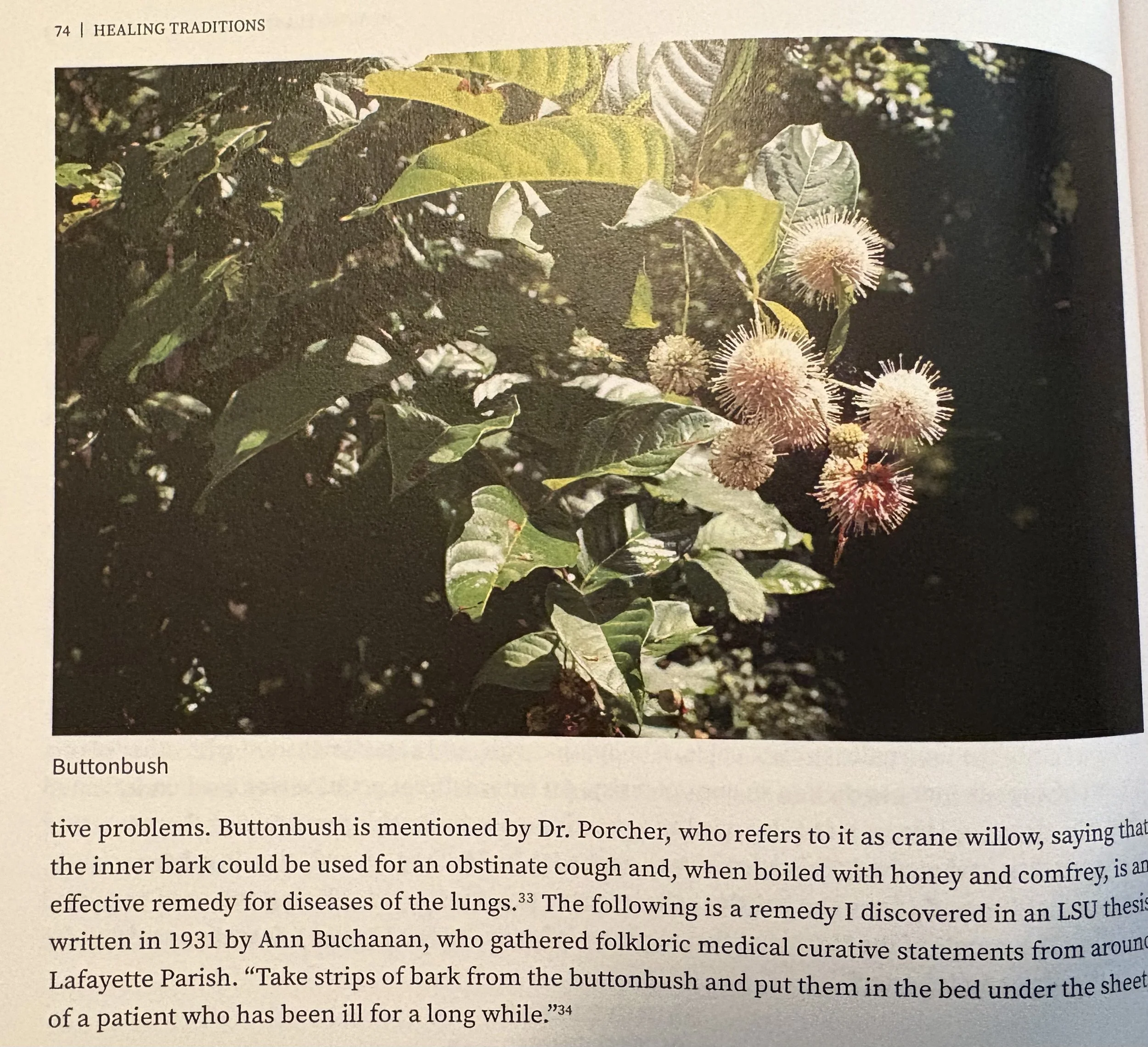Button Bush
written by Carmin Nezat
Button Bush! Cephalanthus occidentalis. Other common names include buck brush, button-willow or honey bells.
Native to eastern and southern North America. It is a common shrub in wetland habitats including swamps, floodplains, mangroves, riparian zones and moist forest understory.
The Cajuns call it “Bois de Marais,” or “swamp wood.” In Quebec, it is known as “bois noir,” or “black wood.” Traditional Cajun use is as a tea of the roots for fever and as a digestive aid. Root tea has also been used medicinally against diabetes.
Image from “Flore Louisiane: An Ethnobotanical Study of French-Speaking Louisiana” by Walter C. Holmes.
Wood ducks utilize it as nest protection and mallards eat the seeds. Hummingbirds and bees frequent the flowers. It is a larval host to the hydrangea sphinx moth, royal walnut moth, and the titan sphinx moth. Deer browse the foliage but this plant is considered poisonous to livestock and most domesticated animals.
African Americans, in the Post Bellum (1865-1969) and Contemporary (1970-present) time periods are recorded as using Button Bush in tincture, infusion, syrup and decoction forms for chills, sore throat, and coughs.
The Chickasaw used a poultice of warmed roots applied to the head for eye troubles.
The Choctaw used a decoction of the root and plant bark for dysentery, as a febrifuge and as a general tonic and as a wash for sore eyes. They also used the bark to chew on for toothaches.
The Koasati (Coushatta) used a decoction of the leaves for rheumatism and a decoction of the roots for enlarged muscles.
In the Creek/ Seminole language, the word for buttonbush is “halpati:hoso:ti” or “sakco meto.” The Seminole used a decoction of bark taken for headaches, fevers and stomach aches. They also used a decoction of the plant for “wolf ghost sickness”: diarrhea and painful defecation and a decoction of roots or berries used for “horse sickness”: nausea, constipation and blocked urination/urine retention. “Decoction of roots taken for menstruation sickness: yellow eyes and skin, weakness and shaking head. If a man has sexual intercourse with a woman during her menstrual period, the results were more serious than the other menstruation sickness. A doctor would never do this, as it would damage the 'medicine' which he has in his body. Other men were, sometimes, willing to take the risk.”
It is little used in modern herbalism; tea made from the bark is astringent, emetic, febrifuge and tonic.
Warning: The leaves contain glucosides and can be toxic in large doses: symptoms include vomiting, convulsions, chronic spasms and muscular paralysis. It is often listed as a poisonous plant. The leaves, especially when wilted, are toxic to domesticated animals. Modern-day herbalists note that the glycosides in buttonbush apparently stimulate the digestive system, causing the release of hydrochloric acid and enzymes. They caution that individuals with ulcers should not use this plant. The bark contains an abundance of cephalanthin, which affects most vertebrates, both cold and warm-blooded, destroys red blood cells, and is an emetic, spasmodic, and eventually produces paralysis.
Image from “Healing Traditions of South Louisiana: Prayers, Plants and Poultices” by Mary Broussard Perrin and Beverly Constantine Fuselier
⚠️ This information is for educational purposes. Do not attempt to use plants unfamiliar to you as a medicine or food, especially when there are noted hazards. Please always do accurate research, be cautious of any allergies you may have, and/or talk to your doctor about Herb-Drug-Interactions before consuming or using wild plants medicinally. Additionally, when foraging, be aware of any contamination from polluted soil, animal waste, herbicides or pesticides, do not EVER forage from roadsides due to both traffic hazards and certainty of roadway pollution.⚠️
Botanical Museum of Harvard University, page 58. BRIT - Native American Ethnobotany Database Cephalanthus occidentalis.
Campbell, T.N., 1951, Medicinal Plants Used by Choctaw, Chickasaw, and Creek Indians in the Early Nineteenth Century, Journal of the Washington Academy of Sciences 41(9):285-290, page 287. BRIT - Native American Ethnobotany Database Cephalanthus occidentalis.
Bushnell, Jr., David I., 1909, The Choctaw of Bayou Lacomb, St. Tammany Parish, Louisiana, SI-BAE Bulletin #48, page 24. BRIT - Native American Ethnobotany Database Cephalanthus occidentalis.
Taylor, Linda Averill, 1940, Plants Used As Curatives by Certain Southeastern Tribes, Cambridge, MA. Botanical Museum of Harvard University, page 58. BRIT - Native American Ethnobotany Database Cephalanthus occidentalis.
Botanical Museum of Harvard University, page 58. BRIT - Native American Ethnobotany Database Cephalanthus occidentalis.
Hamby, Erin Brooke, "The Roots of Healing: Archaeological and Historical Investigations of African American Herbal Medicine. " PhD diss., University of Tennessee, 2004. https://trace.tennessee.edu/utk_graddiss/4543
Hutton, Kimberly, "A Comparative Study of the Plants Used for Medicinal Purposes by the Creek and Seminoles Tribes" (2010). USF Tampa Graduate Theses and Dissertations. https://digitalcommons.usf.edu/etd/1665
Sturtevant, William, 1954, The Mikasuki Seminole: Medical Beliefs and Practices, Yale University, PhD Thesis, page 283., 247, 228, 189, 273. BRIT - Native American Ethnobotany Database. Cephalanthus occidentalis.
Healers-Garden-Brochure-Web.pdf (netdna-ssl.com). Button Bush
medicinal herbs: BUTTON BUSH - Cephalanthus occidentalis (naturalmedicinalherbs.net)





